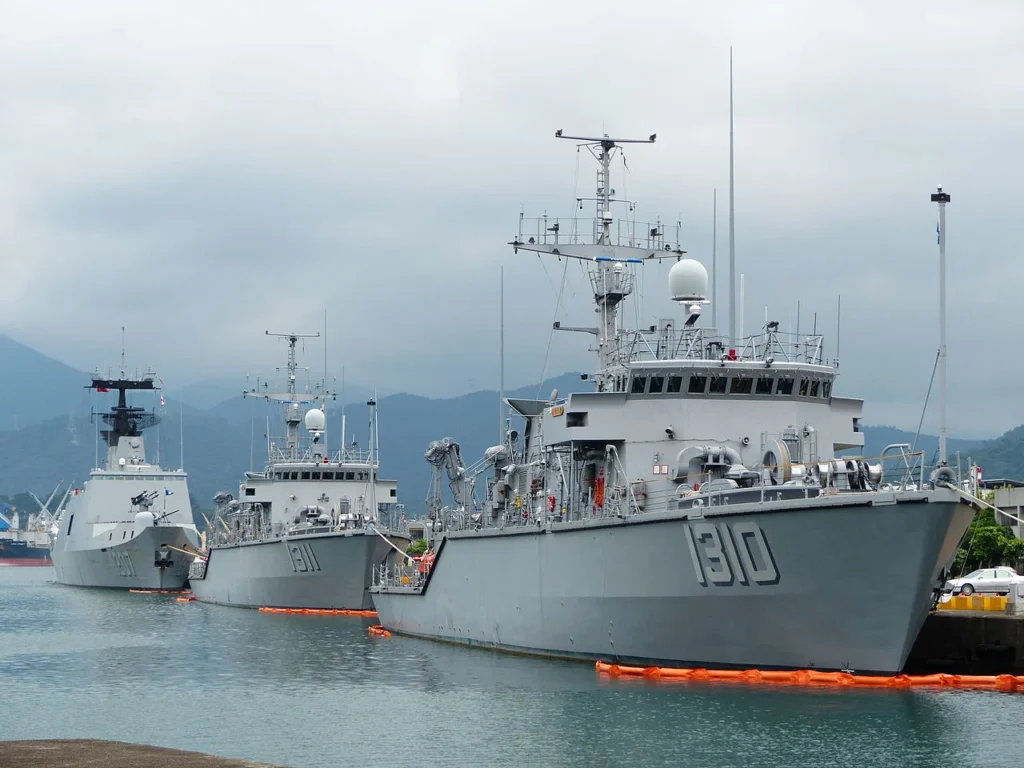The waters surrounding Taiwan have become a silent battleground where an invisible threat lurks beneath the surface. Recent incidents, including an oil tanker explosion near the Taiwanese port city of Kaohsiung and a frigate collision with a naval mine near Keelung’s commercial port, have highlighted a disturbing reality: China’s expanding underwater warfare capabilities represent a significant escalation in cross-strait tensions.
The Hidden Mine Campaign
Intelligence reports suggest that naval mines have been secretly deployed around Taiwan’s coastline, particularly targeting critical port infrastructure. These mines, allegedly dropped by Chinese fishing vessels operating under foreign flags and deployed by submarines of the People’s Liberation Army (PLA), represent a new phase in what many analysts view as preparation for a potential invasion scenario.
The scope of China’s underwater mine capability is staggering. According to U.S. Naval War College estimates, the Chinese military has stockpiled between 50,000 and 100,000 submarine mines across more than 30 different types. This arsenal could potentially grow even larger due to the relative ease of concealing such weapons.
In a full-scale invasion scenario, these mines would serve multiple strategic purposes. Beyond targeting Taiwanese ports and naval facilities, they could be deployed to obstruct potential intervention routes used by allied forces from Australia and Japan. U.S. naval bases in Guam and Japan would likely face similar mine-laying operations, effectively creating a maritime blockade before any formal conflict begins.
A Naval War College analysis indicates that China would need only 7,000 to 14,000 mines to effectively deter Taiwan – a fraction of their estimated stockpile. This surplus suggests China’s underwater warfare strategy extends far beyond the Taiwan Strait.
Strategic Objectives and Capabilities
Chinese military doctrine clearly outlines the role of offensive mine warfare. According to the PLA’s strategic framework, submarine mines serve to “block enemy bases, harbours and sea lanes, destroy enemy sea transport capability, attack or restrict warship navigation, and weaken enemy offensive capability.”
China’s 2008 defence white paper emphasises submarine mines as a primary threat to carrier strike groups and submarines, reflecting their strategic importance in any potential conflict. The stealth advantage of underwater mines becomes particularly significant when considering that submerged vessels operate beyond radar detection range.
The PLA Navy’s submarine fleet provides the primary delivery mechanism for these weapons. With 48 conventional submarines and 12 nuclear-powered vessels, according to recent Pentagon assessments, China possesses substantial covert mine-laying capabilities. Additionally, aircraft such as H-6 bombers can rapidly deploy large quantities of mines, carrying between 12 and 18 depth charges weighing 500 kilograms each.
Gray Zone Operations
China’s underwater warfare extends beyond traditional military scenarios into what experts term “gray zone” operations. Taiwan has accused China of severing underwater communication cables around Taiwan and its offshore islands as part of a broader campaign of maritime harassment that falls short of open warfare but still achieves strategic objectives.
These operations represent a particular challenge for defenders because they can be conducted with plausible deniability, making diplomatic responses difficult while still achieving tactical advantages.
The Minesweeping Challenge
Taiwan faces significant disadvantages in mine countermeasures. The island currently operates only seven mine-sweeping vessels, all of which are aging and potentially inadequate for the scale of threat they might face. This limited capability represents a critical vulnerability in Taiwan’s defensive strategy.
The United States and its allies would similarly struggle with mine clearance operations in the event of a conflict. Modern naval mines can be programmed with sophisticated triggers and timers, making them extremely difficult to detect and neutralise safely.
Taiwan’s Response
Recognising these vulnerabilities, Taiwan has begun upgrading its mine warfare capabilities. The navy currently operates four dedicated minesweeper vessels, with plans for significant expansion. On April 16, 2025, the government signed a contract with Lungteh Shipbuilding Company to construct six additional minesweepers, featuring 41-meter steel hulls designed for modern mine warfare operations.
These new vessels are scheduled for completion by the end of 2026, though many analysts question whether this timeline provides adequate preparation for the current threat level. Taiwan’s 192nd Fleet, based in Kaohsiung, maintains mine-laying capabilities with vessels capable of carrying up to 64 mines manufactured by Wan Hsiang Company.
Implications for Regional Security
The growing sophistication of China’s underwater operations represents a fundamental shift in the military balance across the Taiwan Strait. Unlike conventional naval warfare, mine operations can be conducted covertly over extended periods, potentially creating fait accompli situations that complicate international responses.
The psychological impact of these operations cannot be understated. Commercial shipping companies may begin avoiding Taiwanese ports if mine threats become more frequent, potentially achieving economic blockade effects without formal declaration of hostilities.
For Taiwan’s defence planners, the mine threat requires a complete reconsideration of naval strategy. Traditional surface fleet operations become significantly more dangerous in mine-infested waters, while the island’s critical ports and harbours face unprecedented vulnerability.
As underwater warfare technology continues to evolve, the strategic implications extend far beyond the Taiwan Strait. The combination of traditional mines with advanced unmanned systems creates new categories of threats that existing international maritime law may be ill-equipped to address.
The current situation demands immediate attention from Taiwan’s allies and the broader international community. The time for reactive measures may be rapidly passing, as China’s underwater capabilities appear to be transitioning from development to deployment phase.
The waters around Taiwan have become a testing ground for the future of naval warfare, where invisible threats beneath the surface may ultimately determine the fate of one of the world’s most strategically important regions.

